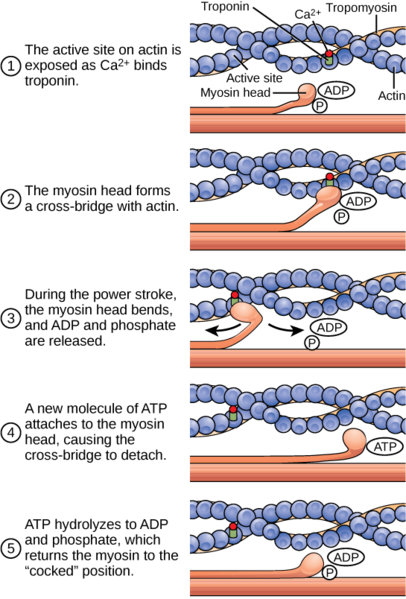
Physiology
Basic Cellular
The two principal contractile proteins in skeletal muscle are:
Answer:
The two principal contractile proteins in skeletal muscle are actin and myosin. Each muscle fibre is composed of myofibrils separated by sarcoplasm and arranged in a parallel fashion along the long axis of the cell. Each myofibril is further subdivided into thick and thin myofilaments which are responsible for the cross-striations. The thin filament consists of two intertwining strands of actin with smaller strands of tropomyosin and troponin between the intertwining strands. The thick filament is composed predominantly of myosin.Sliding Filament Theory
Physiology / Basic Cellular / Skeletal Muscle Physiology
Last Updated: 29th July 2024
Myofilaments
The thin filament consists of two intertwining strands of actin with smaller strands of tropomyosin and troponin between the intertwining strands. The thick filament is composed predominantly of myosin. Each molecule is club shaped, with a thin tail, comprising two coiled peptide chains and a head made up of two heavy peptide chains and four light peptide chains. The ATPase activity of the myosin molecule is concentrated in the head. The thin tails of the myosin form the bulk of the thick filaments, whereas the heads project outwards to form cross bridges between the thick filaments and their neighbouring thin filaments.

Myofilaments. (Image by OpenStax [CC BY 4.0 , via Wikimedia Commons)
Muscle Contraction
The contraction of muscle is triggered by the release of Ca2+ from the sarcoplasmic reticulum where it is stored bound to calsequestrin. This raises the concentration of calcium which saturates the binding sites on troponin. This results in a shift of tropomyosin, exposing actin binding sites thus allowing myosin cross-bridges to form with actin.
The myosin head then pivots and bends as it pulls on the actin filament sliding it towards the M line. Release of ADP and Pi from the myosin head frees the head for another molecule of ATP. As new ATP attaches to the myosin head, the cross bridge detaches and frees the myosin head for further binding. ATP is hydrolysed to ADP and Pi, returning the myosin head to the 'cocked' position. Like fingers of the hands sliding over one another, actin and myosin molecules slide past each other.
This mechanism is called the sliding filament theory. The muscle fibre itself does not shorten in contraction, but the sarcomere shortens as the thick and thin filaments slide over one another. This constant interaction of the thin and thick filaments, binding, tilting, releasing and rebinding and sliding over one another using cross-bridges will continue as long as Ca2+ remains high. The duration of the contraction is dependent on the rate at which the sarcoplasmic reticulum pumps back the Ca2+ into the terminal cisternae.

Sliding Filament Theory. (Image by CNX OpenStax [CC BY 4.0 , via Wikimedia Commons)
Report A Problem
Is there something wrong with this question? Let us know and we’ll fix it as soon as possible.
Loading Form...
- Biochemistry
- Blood Gases
- Haematology
| Biochemistry | Normal Value |
|---|---|
| Sodium | 135 – 145 mmol/l |
| Potassium | 3.0 – 4.5 mmol/l |
| Urea | 2.5 – 7.5 mmol/l |
| Glucose | 3.5 – 5.0 mmol/l |
| Creatinine | 35 – 135 μmol/l |
| Alanine Aminotransferase (ALT) | 5 – 35 U/l |
| Gamma-glutamyl Transferase (GGT) | < 65 U/l |
| Alkaline Phosphatase (ALP) | 30 – 135 U/l |
| Aspartate Aminotransferase (AST) | < 40 U/l |
| Total Protein | 60 – 80 g/l |
| Albumin | 35 – 50 g/l |
| Globulin | 2.4 – 3.5 g/dl |
| Amylase | < 70 U/l |
| Total Bilirubin | 3 – 17 μmol/l |
| Calcium | 2.1 – 2.5 mmol/l |
| Chloride | 95 – 105 mmol/l |
| Phosphate | 0.8 – 1.4 mmol/l |
| Haematology | Normal Value |
|---|---|
| Haemoglobin | 11.5 – 16.6 g/dl |
| White Blood Cells | 4.0 – 11.0 x 109/l |
| Platelets | 150 – 450 x 109/l |
| MCV | 80 – 96 fl |
| MCHC | 32 – 36 g/dl |
| Neutrophils | 2.0 – 7.5 x 109/l |
| Lymphocytes | 1.5 – 4.0 x 109/l |
| Monocytes | 0.3 – 1.0 x 109/l |
| Eosinophils | 0.1 – 0.5 x 109/l |
| Basophils | < 0.2 x 109/l |
| Reticulocytes | < 2% |
| Haematocrit | 0.35 – 0.49 |
| Red Cell Distribution Width | 11 – 15% |
| Blood Gases | Normal Value |
|---|---|
| pH | 7.35 – 7.45 |
| pO2 | 11 – 14 kPa |
| pCO2 | 4.5 – 6.0 kPa |
| Base Excess | -2 – +2 mmol/l |
| Bicarbonate | 24 – 30 mmol/l |
| Lactate | < 2 mmol/l |

